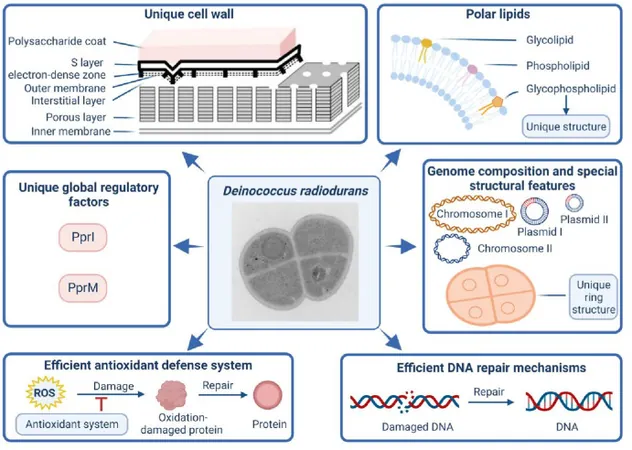
Unveiling the Secrets of Deinococcus radiodurans: The Antioxidant Behind Extreme Radiation Resistance
2024-12-19
Author: Jia
Introduction
Extremophiles are some of the most fascinating organisms on our planet, demonstrating capabilities far beyond typical life forms. One stunning example is the bacterium Deinococcus radiodurans, which can withstand ionizing radiation at levels that would swiftly incapacitate humans. But how does this remarkable bacterium manage such incredible feats of survival? Researchers have recently illuminated some of the key components involved in its extreme radiation resistance.
The Role of MDP in Radiation Resistance
At the heart of its resilience lies a unique antioxidant synthesized from a combination of various metabolites and manganese. This complex, known scientifically as MDP (manganese-dominated peptide), consists of manganese ions, phosphate, and a small peptide, which has already shown promise for use in developing vaccines, particularly for the chlamydia bacterium. A study published in 2023 in *Radiation Medicine and Protection* by Feng Liu and colleagues highlights that the MDP antioxidant is just one piece of a much more intricate survival puzzle.
Additional Defense Mechanisms
While the MDP compound plays a critical role in neutralizing ionizing radiation, it’s not the bacterium’s only line of defense. Deinococcus radiodurans also possesses sophisticated DNA repair mechanisms to address damage that occurs despite the antioxidant's protective effects. This multifaceted approach to survival allows the organism to thrive in environments with radiation levels thousands of times greater than what is typically fatal for humans.
Human Application and Misconceptions
However, the idea that humans could simply inject themselves with MDP to acquire radiation resistance is a misconception. According to experts, replicating the superpowers of D. radiodurans in people involves much more than just one compound; it requires a full understanding of the numerous genetic and biochemical adaptations that contribute to this extremophile’s extraordinary resilience.
Future Perspectives
As research into the capabilities of extremophiles like D. radiodurans expands, it opens new doors not only in understanding biology but also in potential applications in medicine and biotechnology. Imagine developing therapies to protect humans from radiation during cancer treatments or improving food preservation through enhanced resistance to radiation. The future looks promising as scientists peel back the layers of these remarkable organisms, revealing applications that could benefit humanity in ways we’re only beginning to explore.



 Brasil (PT)
Brasil (PT)
 Canada (EN)
Canada (EN)
 Chile (ES)
Chile (ES)
 España (ES)
España (ES)
 France (FR)
France (FR)
 Hong Kong (EN)
Hong Kong (EN)
 Italia (IT)
Italia (IT)
 日本 (JA)
日本 (JA)
 Magyarország (HU)
Magyarország (HU)
 Norge (NO)
Norge (NO)
 Polska (PL)
Polska (PL)
 Schweiz (DE)
Schweiz (DE)
 Singapore (EN)
Singapore (EN)
 Sverige (SV)
Sverige (SV)
 Suomi (FI)
Suomi (FI)
 Türkiye (TR)
Türkiye (TR)